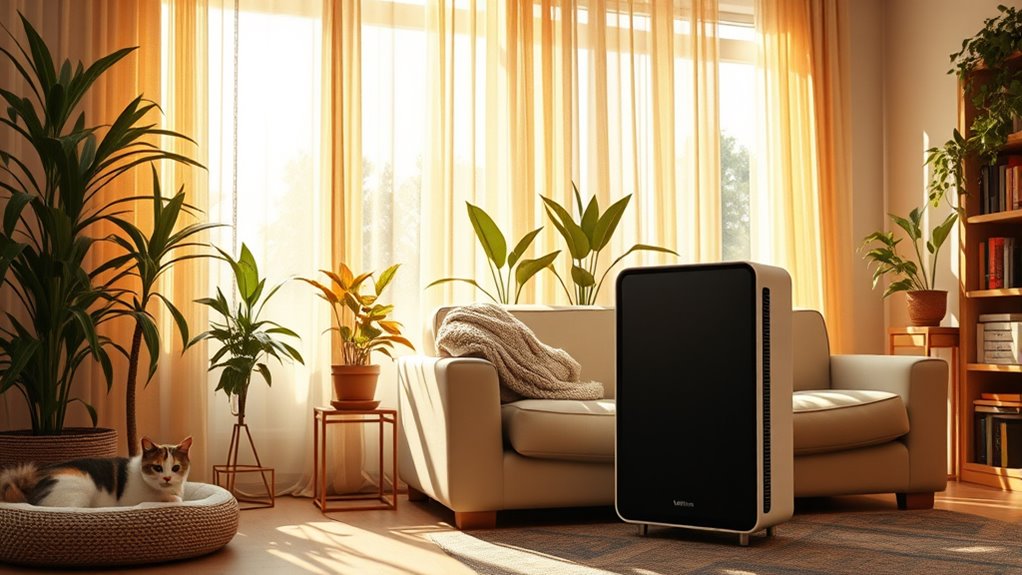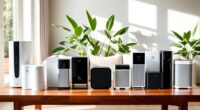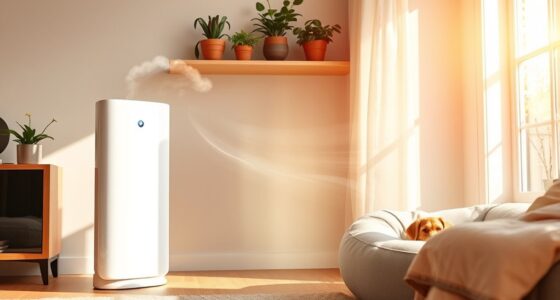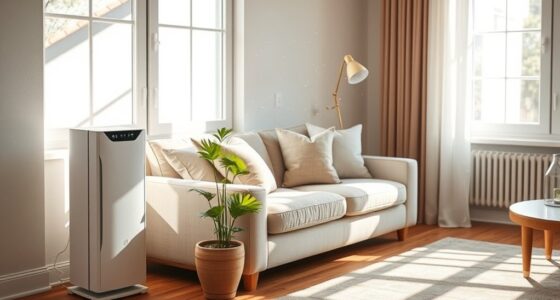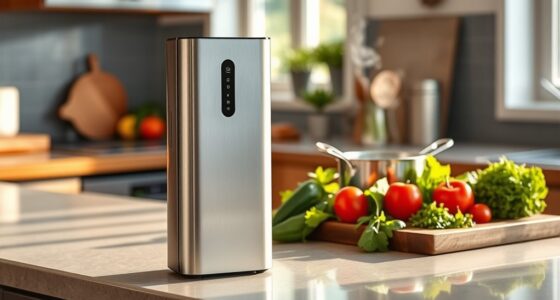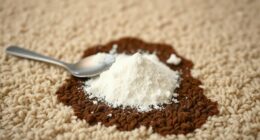Common indoor air pollutants like tobacco smoke and mold can seriously impact your health. Tobacco smoke contains harmful chemicals, while mold can trigger allergies and asthma. Air purifiers with HEPA filters capture these pollutants effectively, including pet dander and volatile organic compounds (VOCs). They can help improve air quality and reduce odors in your home. If you’re interested in understanding how to maximize the benefits of air purifiers, you’ll find even more insights ahead.
Key Takeaways
- Tobacco smoke contains harmful chemicals, and air purifiers with HEPA filters can capture airborne particles, reducing exposure to secondhand smoke.
- Mold thrives in damp environments, but HEPA air purifiers effectively capture mold spores and help maintain lower humidity levels.
- Volatile Organic Compounds (VOCs) from household products can cause health issues; air purifiers with activated carbon filters can reduce VOC levels significantly.
- Regular maintenance of air purifiers, including timely filter replacements, enhances their efficiency in removing allergens and pollutants.
- Choosing air purifiers with an appropriate Clean Air Delivery Rate (CADR) ensures optimal performance tailored to room size for better air quality.
Understanding Common Indoor Air Pollutants
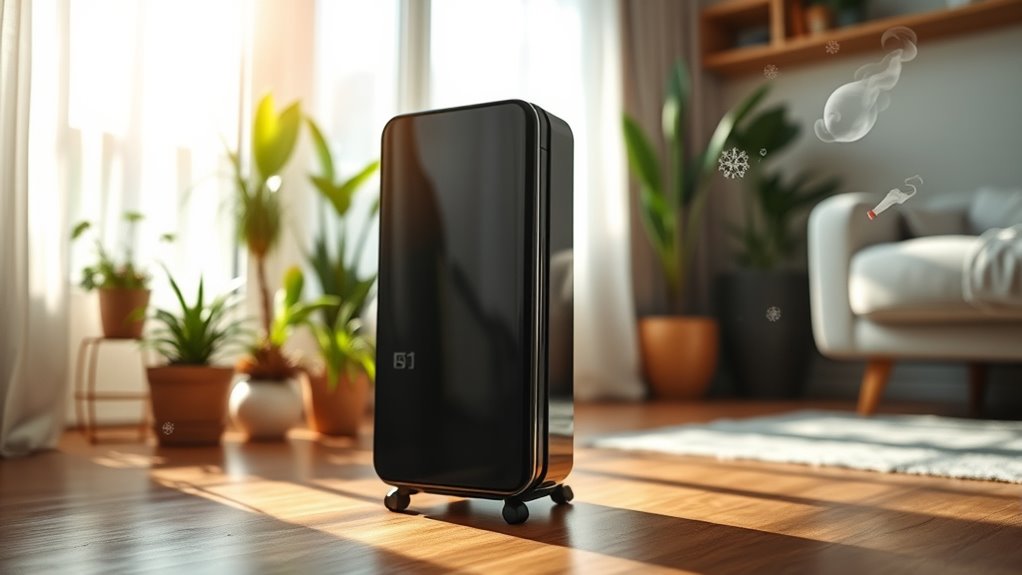
While you mightn’t see them, common indoor air pollutants can considerably impact your health and well-being.
Tobacco smoke contains over 7,000 chemicals, leading to respiratory diseases and cancer. Mold thrives in damp areas, triggering severe allergies and asthma. HEPA filters are particularly effective at capturing mold spores, improving air quality. In addition, air purifiers with UV light technology can further enhance air quality by eliminating bacteria and viruses. Regular maintenance of these devices ensures they function optimally to combat such pollutants. Furthermore, indoor air quality can be up to 5 times worse than outdoor air, emphasizing the necessity of air purification.
You may also encounter volatile organic compounds (VOCs) from everyday products, causing headaches at high concentrations. Carbon monoxide, an odorless gas from fuel combustion, can be fatal in elevated levels.
Pet dander acts as an allergen, worsening asthma symptoms, while indoor particulate matter, including dust and smoke, poses risks to lung health. Regular filter replacement is essential for ensuring continuous removal of these allergens and pollutants.
Finally, radon, a colorless gas seeping from the soil, is a leading cause of lung cancer among non-smokers.
Using air purifiers equipped with HEPA filters helps reduce these harmful pollutants effectively. Additionally, user satisfaction with air purifiers often highlights significant reductions in allergens and odors, showcasing their importance in maintaining a healthy indoor environment.
The Impact of Tobacco Smoke on Indoor Air Quality
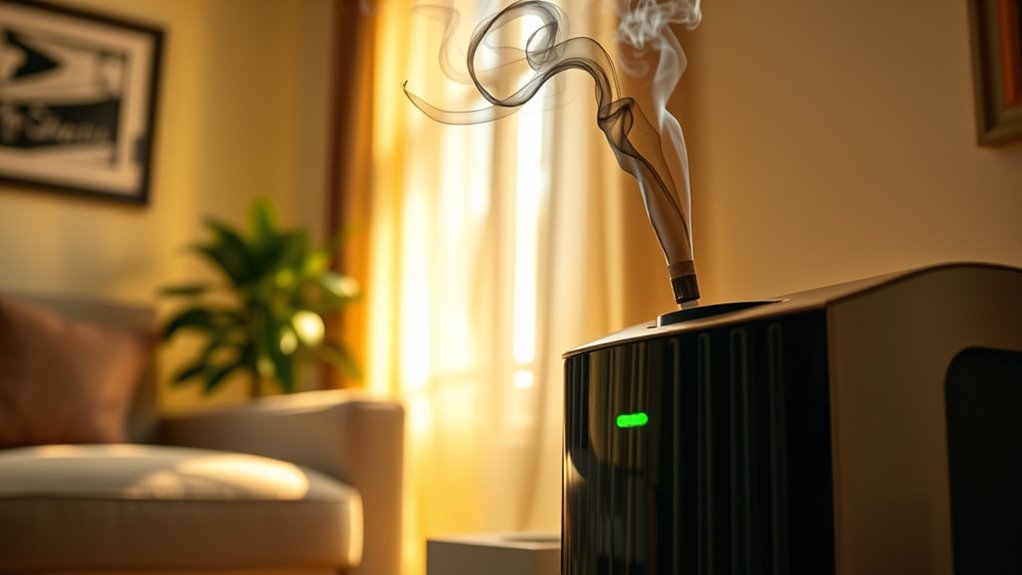
Indoor air quality can be severely compromised by tobacco smoke, which introduces a host of harmful chemicals into your environment. This type of indoor air pollution is particularly concerning due to the presence of carcinogens and particulate matter. Secondhand smoke poses considerable health risks, including respiratory problems and increased lung cancer rates among non-smokers. In fact, indoor air quality can be worse than outdoor pollution from diesel exhaust. Maintaining skin health is crucial, as tobacco smoke can also negatively affect your skin’s appearance. Regularly using air purifiers with HEPA filters can significantly enhance the air quality by effectively capturing these harmful pollutants. Additionally, continuous monitoring of air quality is essential to mitigate the risks associated with tobacco smoke exposure. Furthermore, investing in best home security systems can help ensure a safe environment for individuals who wish to avoid exposure to tobacco smoke.
| Health Risks | Sources of Pollution | Air Quality Impact |
|---|---|---|
| Carcinogens | Tobacco smoke | Exceeds outdoor levels |
| Respiratory issues | Secondhand smoke | Long-lasting effects |
| Particulate matter | Residual smoke | Harmful to vulnerable |
| Annual deaths | Exposure to smoke | 7,300 lung cancer deaths |
Using air purifiers with HEPA filters can greatly improve your indoor air quality. Additionally, models like the LEVOIT Air Purifier are effective in smoke filtration, making them beneficial for households affected by tobacco smoke.
Addressing Mold and Its Health Risks
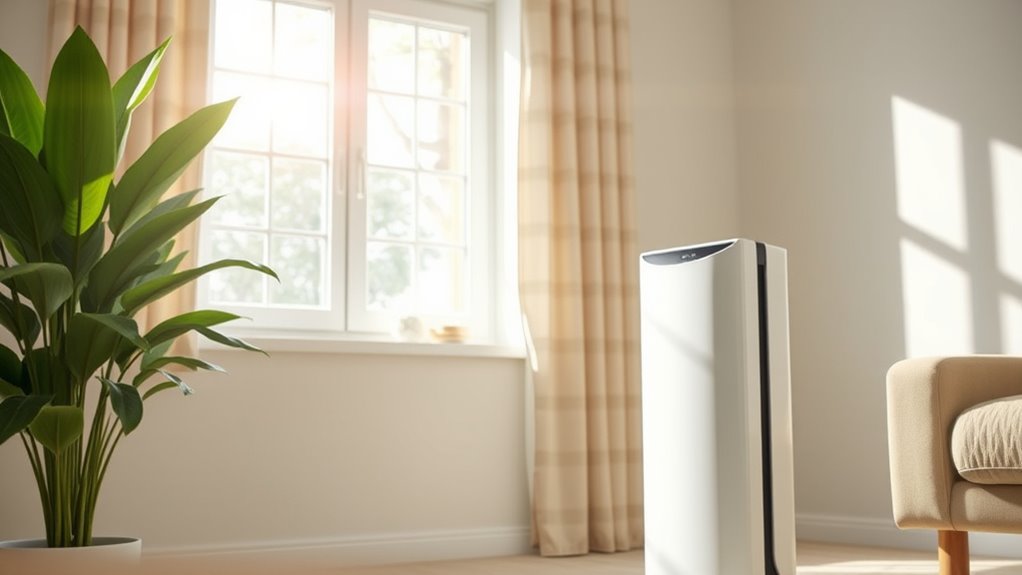
Mold can pose significant health risks, especially if it’s allowed to flourish in damp areas of your home. Inhalation of mold spores can trigger respiratory infections and severe allergies, which is particularly dangerous for children and those with existing health issues. Homes without security systems are 300% more likely to be burglarized, underscoring the importance of a safe and healthy living environment. Regular maintenance of your HVAC systems is essential in preventing mold growth, as proper care can significantly enhance their efficiency and effectiveness in controlling humidity levels. Additionally, employing energy-efficient heat pumps can help maintain optimal humidity levels in your home, further reducing the likelihood of mold growth.
To combat mold, keep indoor humidity levels below 50%, as high moisture levels create an ideal environment for it to thrive. Regular cleaning and maintenance of your HVAC systems are essential in preventing mold growth. Additionally, using HEPA air purifiers can effectively capture mold spores from the air, greatly improving your indoor air quality. By addressing these mold-related health risks proactively, you can create a healthier living space for you and your family. Consistent maintenance of air purifiers ensures they operate at peak efficiency and effectively reduce airborne mold spores. Furthermore, the use of commercial grade heat pumps can further enhance air quality by providing consistent temperature control and reducing humidity levels.
The Role of Air Purifiers in Reducing VOCs
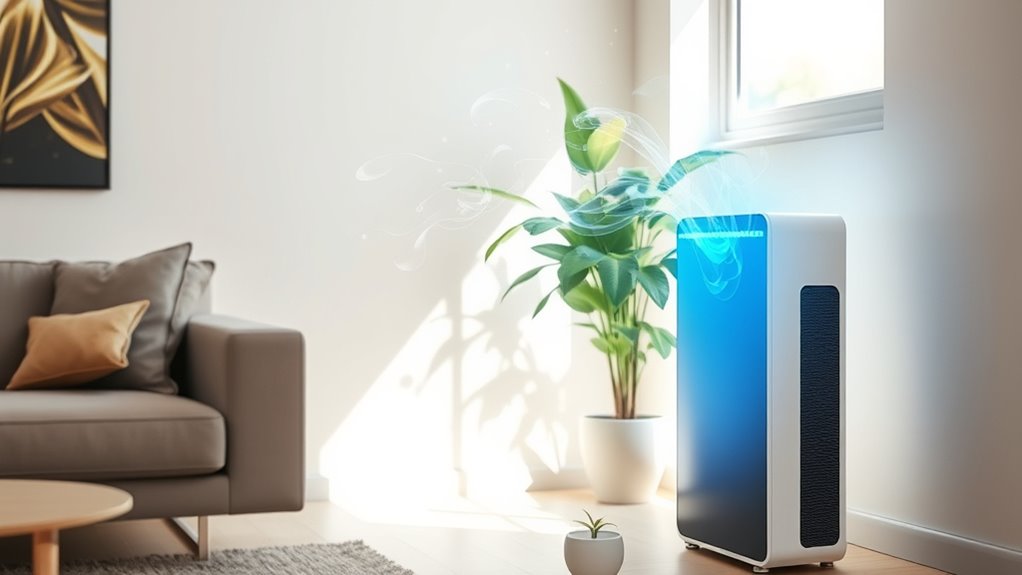
After tackling mold issues, it’s important to reflect on another common indoor threat: Volatile Organic Compounds (VOCs).
Emitted from household products like paints and cleaning supplies, VOCs contribute to indoor air pollutants and health effects such as headaches and respiratory irritation. AI in Marketing strategies can help in developing effective air purification solutions by analyzing user data for better product targeting. Additionally, gold and silver are commonly favored for diversification in investment portfolios, similar to how air purifiers diversify your air quality improvement strategies. Furthermore, heat pumps can also enhance indoor air quality by filtering and circulating air, which complements the functionality of air purifiers.
Air purifiers play an essential role in reducing exposure to these harmful compounds. Here’s how they help:
- Activated carbon filters adsorb VOCs effectively.
- HEPA filters capture particulate matter linked to VOCs.
- They can lower VOC levels by up to 50% within hours.
- Regular maintenance and filter replacement guarantee peak performance.
- Using air purifiers considerably enhances air quality in your home.
- Additionally, incorporating essential oils in your cleaning routine can further improve indoor air quality. The presence of soluble fiber in certain products can also contribute to a healthier indoor environment.
Investing in an air purifier can create a healthier living environment for you and your family.
Mitigating the Effects of Pet Dander and Other Allergens
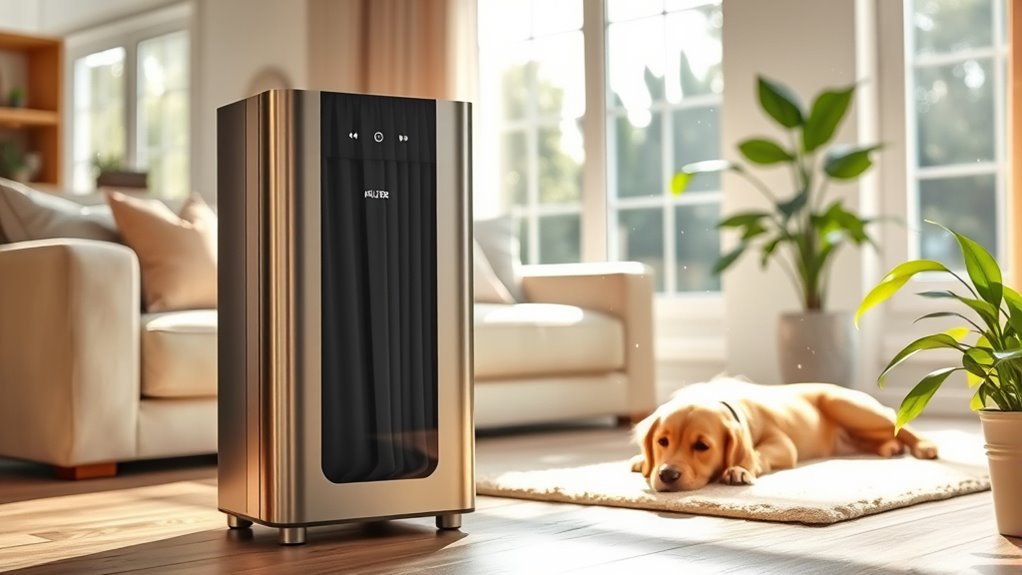
While pets bring joy to our homes, they also introduce allergens like pet dander that can trigger discomfort for those with sensitivities.
To mitigate the effects of pet dander and other allergens, regular cleaning and vacuuming are essential, but they may not be enough. Air purifiers equipped with HEPA filters capture up to 99.97% of airborne particles, considerably improving indoor air quality.
These devices also tackle other airborne pollutants, such as dust mites and mold spores, ensuring a thorough approach to allergen removal. Additionally, air purifiers with activated carbon filters neutralize odors and capture volatile organic compounds (VOCs) emitted from household products.
Choosing a purifier with an appropriate Clean Air Delivery Rate (CADR) for your room size enhances its effectiveness, promoting a healthier living environment. Furthermore, regular filter cleaning and replacement are crucial for optimal performance of air purifiers, ensuring they function effectively in removing allergens.
Frequently Asked Questions
What Are the Most Common Indoor Air Pollutants?
You’ll find several common indoor air pollutants affecting your home environment.
Tobacco smoke, filled with harmful chemicals, can lead to serious health issues.
Mold thrives in damp areas, releasing spores that worsen allergies and asthma.
Volatile Organic Compounds (VOCs) from everyday products can trigger headaches and respiratory problems.
Don’t forget about pet dander, which poses challenges for allergy sufferers, and indoor particulate matter, which can impact your overall health considerably.
Do Air Purifiers Help With Indoor Pollution?
Yes, air purifiers can definitely help with indoor pollution. They actively filter out harmful particles, improving the air quality in your home.
When you use one, you’ll notice a reduction in dust, allergens, and unpleasant odors. If you’ve got asthma or allergies, an air purifier can create a healthier environment for you.
Just remember, keeping the filters clean and replacing them regularly is essential to maintain their effectiveness.
What Are the Top 5 Major Air Pollutants?
When considering the top five major air pollutants, you’ve got tobacco smoke, mold spores, volatile organic compounds (VOCs), carbon monoxide, and pet dander.
Tobacco smoke contains harmful chemicals, while mold thrives in damp areas and can trigger allergies.
VOCs come from everyday products, carbon monoxide is a dangerous gas from incomplete combustion, and pet dander can worsen asthma.
Being aware of these pollutants can help you take steps to improve your indoor air quality.
Which of the Following Is a Common Indoor Air Pollutant?
Did you know that indoor air can be up to five times more polluted than outdoor air?
When you think about common indoor air pollutants, you might consider tobacco smoke, which contains thousands of harmful chemicals.
Mold is another culprit, thriving in damp areas and releasing spores that can trigger allergies.
Don’t forget about pet dander, which can affect those with sensitivities.
Recognizing these pollutants is the first step toward a healthier indoor environment.
Conclusion
In summary, tackling indoor air pollutants is essential for your health and comfort. With air purifiers, you can breathe easier, knowing they effectively reduce harmful substances like tobacco smoke, mold, and allergens. Don’t underestimate their power—these devices can transform your home into a sanctuary of clean air, almost like having a personal breeze from the Himalayas! By investing in an air purifier, you’re not just improving air quality; you’re investing in a healthier, happier life for you and your loved ones.
